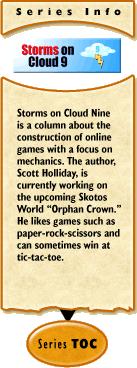
Cliché Practicalityby Scott Holliday Considering the numbers of online worlds, one might surmise that they would be presented with a vast host of very different games, systems, and realities. An experienced seeker can usually find a game and world that suits their tastes, though may find their world to be somewhat lonely. Restricting the analysis only to the larger, more successful online worlds, one is met with another picture entirely. It is fairly simple to locate and join large, lively worlds, but their differences are often insubstantial.
Fantasy worlds make up the vast majority of online games. Although there are a few successful online worlds which break the mold, all of them together likely don't equal any single one of the bigger fantasy worlds. Sword and sorcery, monsters and magic, quests and rewards. More specifically, the majority are stereotypical fantasy worlds built on the clichéd elves, dwarves, and halflings. Throw in trolls, or dragons, dryads, tigermen, or whatever… you still know the world before you even play. Isn't it strange that such a small proportion of fantasy literature is used for such a large proportion of the available games? Why is this stereotype so popular? Perhaps the vague branding makes it easier for the player to quickly assimilate? I would guess that every literate person on earth would be able to draw an elf, a dwarf, and a halfling. Certainly any gamer would be able to tell you the stereotypical differences in each. But what percentage of even experienced readers and gamers would know who or what an uncegila is? So you can't really fault designers for building products for a known and accepted (if somewhat vague) franchise. Scantily clad women? When in comes to graphics, I think beautiful vistas, interesting environments, dynamic water and trees, realistic movements of characters and actions. All these provide a nice sparkle and heightened sense of immersion. Although players like me still appreciate text-based games for their beauty, vocabulary, and often deeper complexities, the paying masses do not agree. Still, I think the make or break point of a game is whether it has scantily clad women. Although the majority of online gamers are over twenty, each new game wants to bring in the new blood. If you have any doubts about the biggest attraction, try watching a single television show aimed at that age group. And even among older crowds sex appeal sells… in ways we'd usually never even consider. A friend of mine recently commented that MMORPG stands for "mostly men online role playing girls." Of course I laughed, while still remembering some of the females characters I've played in the past. As a curious experimenter and explorer, repeatedly slaughtering rats has always been one of my pet peeves. However, I know that I'm not within the normal statistical curves of paying players. The MMORPG has simply copied the reward system that worked so well to keep players busy and entertained in single player games. Looking at subscription numbers, it's hard to refute that it works. Similarly, since the same system can be repeated over and over again with minimal changes to make it unpredictable, it's an easy money maker. Although I'm not one to follow the carrot, most paying players seem to be happy to do so. Once again, the question is why? It sells, yes, but why? My best guess is that this is what players expect. They expect it, so that is what they want, so that is what is provided, so that is what is sold. Self-fulfilling prophecies? Yes and no. As I said at the beginning, there are notable exceptions. The question for the future is whether or not the exceptions will gain enough interest to justify there being even more like them. As a final note, if designers are trained to recognize and appreciate one main system, what games are they likely to want to build? These past few years have seen a plethora of MMORPG clones. Almost direct copies of the look, feel, and gameplay of games that went before. My first expectation was that they would all fail, since the player base would prefer the original. Although most haven't even challenged their forbears, most have survived and grown to be profitable and self-sufficient. On the other hand, the competition isn't quite so fierce since even more were cancelled before reaching a playable state. [ <— #35: Order and Planning | #37: Filling the Sandbox —> ] |
